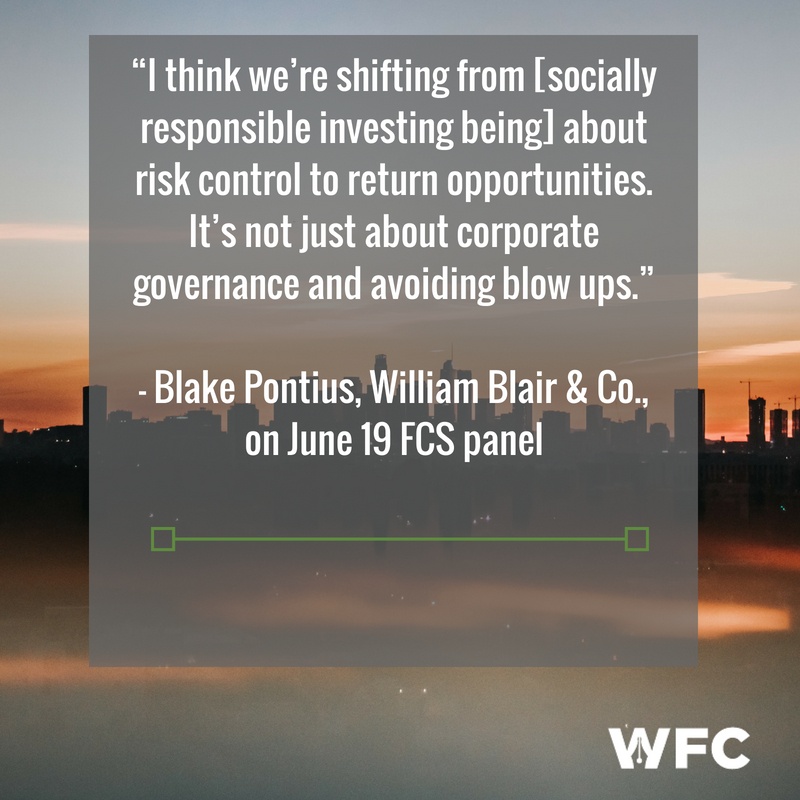Investors are increasingly wanting to add purpose to their portfolios.
Roughly $8.7 trillion was invested in accordance with sustainable or responsible investment strategies in the United States in 2016, according to data from US SIF: The Forum for Sustainable and Responsible Investment. That represents a 33 percent increase from 2014, the last year the group collected data, and about one of every five dollars under professional management in the United States.
The growing popularity of this form of investing has taken on many names, from impact investing to socially responsible investing (SRI), mission-related investing, and environmental, social, and governance (ESG) factor-based investing. Driving the trend is a desire from investors—retail, high-net-worth, and institutions—to be more conscientious about the social forces behind their returns.
But this growing corner of the investment universe is full of confusion around what sustainable and responsible investing means and how it’s applied. Moreover, how are different players in the investment industry—institutional asset managers, private wealth managers, research firms and advisories, among others—approaching the subject with their clients?
On June 19, representatives from across the asset management industry tackled these questions as a panel for members of the Chicago chapter of the Financial Communications Society. The event, “Impact Marketing for Impact Investing,” gathered roughly 50 marketing and sales executives from the financial services industry at the Union League Club of Chicago. Wentworth Financial Communications’ very own Scott Wentworth moderated the panel.
Here’s a recap of the most valuable insights the panelists, listed below, provided to the audience.
The panel:
- Blake Pontius, Global Equity Portfolio Specialist, William Blair & Company
- Elizabeth Pultz, Marketing, Retirement & Investment Services, Aon Hewitt
- Colin Rennich, Director of Sales, Appleseed Capital
- John Hale, Head of Sustainable Investing Research, Morningstar
Socially responsible investing has grown more popular partly because equity research in the area has become more sophisticated.
Just as the rise of technology has given way to greater access to information on the financial performance of public companies, a similar dynamic has occurred when it comes to information about companies’ social and environmental impact.
“The idea of using ESG-related information … in an investment process has become much more sophisticated,” said Morningstar’s John Hale, “partly because for a number of years ESG research on companies has become sophisticated enough for asset managers to use it.”
In other words, the research on ESG factors has advanced to the point where asset managers and other investors are able to dig into the details of a company’s business practices and performance to judge the degree to which companies are actually affecting the environment or driving social change. Learn more about the Morningstar Sustainability Rating.
Definitions for the various types of sustainable and responsible investing are becoming clearer—but there’s still confusion among investors about taxonomy.
Many investors assume that terms like ESG investing, SRI, or impact investing represent the same thing. But as Aon’s Elizabeth Pultz said, these terms aren’t synonymous with one another.
What’s more, the difference in how you categorize these different forms of investing—“whether you’re talking about mission investing vs. SRI investing vs. ESG”—is significantly impacting returns, Pultz said.

“The demand for education and taxonomy—we have to get to a new normal, because it’s not a tomato/tomato thing; it’s impacting returns,” Pultz said.
Aon worked to clear up this confusion as part of its recent Global Perspectives on Responsible Investing report. The white paper, which summarizes the findings from Aon’s first survey of institutional investors about their attitudes on responsible investing, includes a section that defines the four categories of responsible investing:
- Socially Responsible Investing: Using negative screening to avoid companies whose activities conflict with the investor’s values, such as selling tobacco or firearms
- Impact Investing: Using positive screening to invest in companies that are “doing well by doing good,” such as investing in clean water initiatives
- Environmental, Social, and Governmental Integration: Analyzing how non-financial, objective factors in these areas are affecting a company’s performance
- Mission-Based Investing: Combining elements of the three categories above to advance the investor’s values
Firms are crafting their messages around sustainable and responsible investing differently depending on the audience.
Colin Rennich of Appleseed Capital, which serves both institutional and private wealth clients, said the way the firm approaches its messaging around sustainable and responsible investing varies depending on the audience.
For instance, when working with high-net-worth individuals, Appleseed may approach the subject by asking investors what their personal values are and how they would like those values reflected in their investment portfolio. “And those could be negative and positive,” Rennich said. “It could be, what are the things that you want to avoid? Or what are the things that you want to support? When you’re working with high-net-worth individuals, typically [they’re] very passionate about both sides, so that’s much more customizable.”
On the other hand, institutions want to see more of a track record when it comes to impact investing. “They want to know what you’ve done in the past, so you need a product,” Rennich said. Learn about Appleseed Capital’s approach to impact investing.
Investors view ESG factors as tools for generating alpha, not just mitigating risk.
Investors’ expectations about the benefits of ESG factors are shifting from being more about taking defensive positions to avoid possible scandals or “blow ups”—such as the 2010 BP oil spill in the Gulf of Mexico, which sent the company’s share price plummeting—to being more offensive and opportunistic.
“What we’re seeing now—at least what I’m seeing—is more acceptance of risk-adjusted return and opportunities that are related to companies and making investments on environmental and social factors,” said William Blair’s Blake Pontius.
“I think we’re shifting from it’s about risk control to return opportunities,” Pontius said. “It’s not just about corporate governance and avoiding blow ups.”
He added that investors are increasingly accepting of the idea that environmental and social themes are underpinning growth opportunities for companies. One example he cited was shoe companies making eco-friendly sneakers and being able to sell those shoes at higher margins. Learn more about William Blair’s approach to integrating ESG factors into portfolio management.
…
For more from the June 19 FCS event, you can click below to listen to the audio of the panel or watch a video of the entire panel discussion.
About the Author

Frank Kalman is the chief operations officer at Wentworth Financial Communications. Frank and the team of writers and editors at WFC help professionals across the financial services industry build their brands by creating investment-grade white papers, bylined articles, newsletters, blogs, social media posts, and other forms of content marketing.
